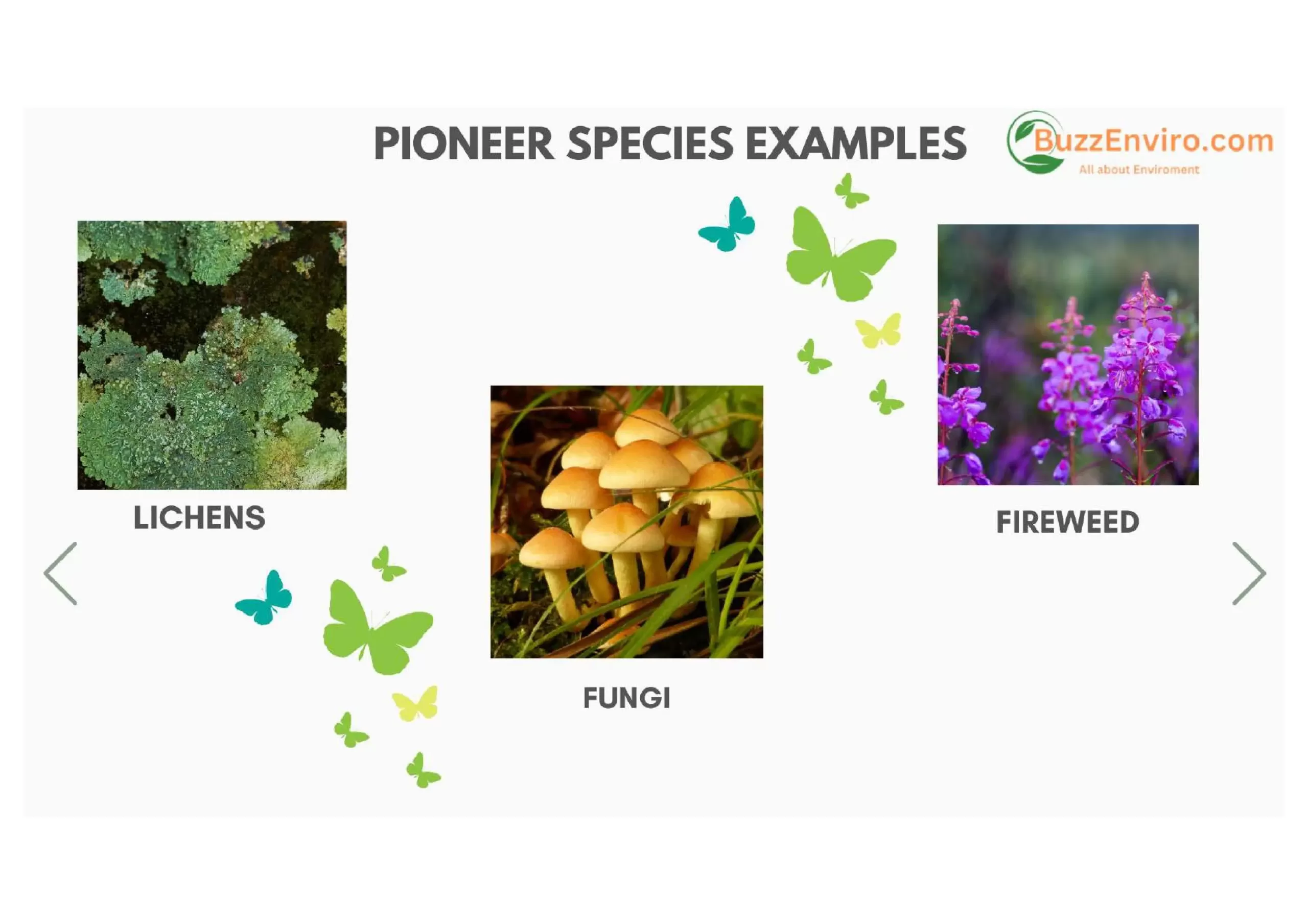In the complex web of ecosystems, the regeneration of life in barren or disturbed environments starts with the arrival of pioneer species. These species act as nature’s first responders, playing a vital role in the initial stages of ecological succession. This blog will explore what pioneer species are, their characteristics, and some notable examples that showcase their importance in restoring ecosystems.
What are Pioneer Species?
Pioneer species are the first organisms to colonize a disturbed or newly formed environment, such as land stripped bare by natural events like volcanic eruptions, floods, or human activity like deforestation. They are the foundation for rebuilding an ecosystem, as they help create the conditions necessary for more complex plant and animal life to flourish. These species are often hardy, adaptable, and resourceful, enabling them to survive in environments with minimal nutrients or extreme conditions.
Characteristics of Pioneer Species
Pioneer species have several distinct characteristics that enable them to succeed in harsh, uninhabited environments:
1. Hardiness and Adaptability
Pioneer species can tolerate extreme temperatures, poor soil conditions, and low nutrient availability. They can survive where other organisms cannot.
2. Rapid Growth and Reproduction
They tend to grow and reproduce quickly, allowing them to colonize new areas effectively and spread across the environment.
3. Minimal Nutrient Requirements
Many pioneer species, especially plants, can grow in nutrient-poor soils or areas with limited water and resources.
4. Symbiotic Relationships
Some pioneer species, such as certain bacteria or fungi, form symbiotic relationships with other organisms to survive. For instance, some bacteria fix nitrogen, enriching the soil for future plant growth.
5. Soil Development
By breaking down rocks, organic matter, and other materials, pioneer species contribute to the formation of soil, which supports more complex plant life in later stages of succession.
Importance of Pioneer Species in Ecological Succession
Ecological succession is the process of changing the species structure of an ecosystem over time. This process can take place in a pristine ecosystem (primary succession) or a degraded ecosystem (secondary succession). Pioneer species play an important role in both of these processes by helping to prepare the new or newly disturbed ecosystem to support more diverse communities.
1. Primary Succession
Primary succession occurs where there is no existing plant life, animal life, insect life, seed life, soil, etc. This is generally where there was no previous community. Technically, primary succession can occur when a previous community is disturbed or removed. However, there must be no existing organic matter for primary succession to occur.
Pioneer species in primary succession are fungi and lichens because they can break down minerals to create soil and then develop organic matter. Once pioneer species colonize an area and begin building soil, other species, such as grasses, start to colonize as well. The complexity of this new community increases as other new species, such as small shrubs and then trees, begin to colonize.
2. Secondary Succession
Secondary Succession, on the other hand, occurs after a community has been disturbed or destroyed by either natural or man-made forces. The vegetation is gone, but the soil remains. Thus, pioneer species can begin secondary succession from roots or seeds in the remaining soil. Seeds can also be transported by wind or animals visiting neighboring communities. Examples of plants that start secondary succession include grasses, alder trees, and birches and pine trees.
Pioneer species such as alder, birches, and grasses thrive in these environments due to their sunny conditions. The behavior of the community after a disturbance is dependent on many things, but most importantly, it depends on the characteristics of the ecosystem before the disturbance. However, because secondary succession starts with some of the original community’s remains, the rate of change is typically much faster than with primary succession.
The following are some of the factors that can affect a community’s growth during secondary succession:
1. Soil condition: Soil quality can affect secondary succession in a variety of ways, including soil pH, soil density, and soil composition.
2. Residual organic matter: The rate of secondary succession and the species of pioneer species are also affected by the amount of soil organic matter remaining after the disturbance. The higher the organic matter content, the more rapid secondary succession is expected.
3. Existing seed banks: Depending on the type of disturbance that occurred to the community, seeds may be left in the soil. It also depends on the proximity of seeds from other sources and may result in a higher number of pioneer species.
4. Residual living organisms: If roots and other subterranean plant structures can survive the disruption, secondary succession will take place faster and more sympathetically to the original environment.
Examples of Pioneer Species
Pioneer species include lichens and fungi, bacteria, fireweed, grasses, alder, and willow.
1. Lichens:-
Lichens are perhaps the most well-known pioneer species. These remarkable organisms are a symbiotic partnership between a fungus and an alga or cyanobacterium. Lichens can colonize bare rock surfaces, secreting acids that break down the rock into soil particles. This initial soil formation is crucial for subsequent plant colonization.
2. Fireweed:-
Known for its rapid colonization of areas cleared by fire, fireweed is a quintessential pioneer species. Its seeds are easily dispersed by wind, and it can quickly dominate a landscape, providing ground cover and reducing erosion.
3. Alder:-
In some ecosystems, nitrogen-fixing plants like alder trees play a crucial role as pioneer species. These trees have symbiotic relationships with bacteria in their root nodules that convert atmospheric nitrogen into a form that plants can use. This process enriches the soil, paving the way for more nutrient-demanding plants.
Below are some examples of situations in which pioneer species have contributed to the succession.
1. Glacial ice

Primary succession is less studied and less detailed than secondary succession. But one of the most fundamental examples of primary succession is found in the Pinedale Ice Sheet in Yellowstone. When the area was covered with glacial ice, soil and vegetation were removed. After the ice subsided and the glacial period ended, pioneer species re-colonized the area by breaking down the bedrock and creating soil for other plant species to colonize.
2. Lava flow
Mount St Helens erupted in 1980, leaving the surrounding areas barren and covered in ash, with very few plants and animals surviving. However, some underground life did survive, including underground root systems for plants such as willow, black cottonwood, and more. In the initial aftermath of the disaster, these root systems, along with alder, fir, and other surviving plants, colonized the raw debris of the landslide and the lava flows.
3. Flood
In 1995, flooding caused extensive damage to plant and animal life along the banks of the Moorman’s and Rapidan rivers within Shenandoah National Park. Much of the damage was gravel and boulders, and since then, plant and animal communities have begun to recover through secondary succession.
4. Wildfire
Secondary succession took place in the wake of the Acadia National Park fire of 1947. The fire burned over 10,000 acres of land in the park. Logging was done to salvage and clean up what had previously been wooded. However, some logs were left behind to encourage the regeneration of forest ecosystems. Secondary succession occurs when the forests have already developed root systems, tree stumps, and seeds that are carried by the wind.
Trees such as birch or aspen, which did not grow in the area at the time, bloomed as soon as they were exposed to the new sunlight. As the trees grew into a canopy, spruce trees and fir trees that had grown well in the past were able to come back, creating the deciduous tree and evergreen tree mix that we know today.
5. Agriculture
Agriculture, particularly slash-and-burn type agriculture, can wreak havoc on the natural world. During the fallow period immediately after agricultural use, there is a process known as secondary succession. This occurs when the remaining seeds, roots, weeds, and pioneer species begin to re-establish themselves on the land. Similar to what happens after logging and other forms of deforestation.
Conclusion
Pioneer species are the unsung heroes of ecosystem restoration. Without them, barren landscapes would remain desolate, and the recovery of ecosystems would be far slower. These resilient organisms showcase nature’s ability to adapt and regenerate, reminding us of the delicate balance in our world’s ecosystems. By understanding and appreciating their role, we can better protect and support the natural processes that keep our planet thriving.





